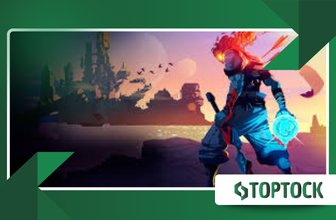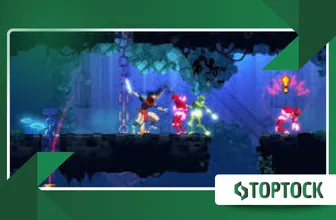Dead Cells: Master Unforgiving Roguelike Runs with Fast‑Paced Combat

Dead Cells. The world of gaming is littered with titles that promise a challenge, but few deliver with the ruthless efficiency of Dead Cells.
Anúncios
This game isn’t just about winning; it’s about learning to accept defeat, to embrace the inevitable and come back stronger.
It’s a masterclass in fast-paced action and the unforgiving roguelike genre, demanding skill, patience, and a bit of luck. Since its full release in 2018, it has captivated millions.
The brilliant minds at Motion Twin crafted a game that feels both familiar and refreshingly unique.
It’s a 2D side-scrolling action platformer with a roguelike structure. You play as a cursed, headless protagonist, a prisoner trapped in a perpetual cycle of life, death, and resurrection.
Anúncios
Each run is a fresh start, a new opportunity to explore the ever-changing island.
The beauty of the game lies in its core loop. You jump, dodge, parry, and slash your way through hordes of enemies.
The combat is incredibly fluid and responsive. It rewards aggression and perfect timing, punishing hesitation with swift and brutal consequences.
The controls are tight, making every action feel deliberate.
Every run feels distinct, thanks to the procedural generation of levels. You’ll encounter new pathways, enemy placements, and item drops.
This prevents the experience from ever becoming stale. It keeps you on your toes, forcing you to adapt your strategy on the fly. You can’t rely on muscle memory alone.
This constantly shifting landscape is what makes the game so addictive. You’re always chasing that one perfect run.
The one where you find the perfect weapon synergy and powerful mutations.
The one where you finally overcome that boss that has been your bane. The one where you finally feel like you’ve mastered the game.
The difficulty is not an arbitrary choice. It’s a fundamental part of the design philosophy.
Read here: Assassin’s Creed Rebellion: Lead Your Brotherhood in Tactical Missions
The game doesn’t hold your hand; it throws you into the deep end and expects you to swim. This can be frustrating, especially at first.
But the sense of accomplishment when you finally overcome a tough obstacle is unmatched.
The Art of the Perfect Run: Weapon Synergies and Mutations
At the heart of the game’s success is its intricate weapon system. You can wield a diverse arsenal of swords, bows, shields, and skills.
Each weapon has unique properties and attack patterns. Finding the right combination of weapons is crucial.
For example, a player might equip a powerful Broadsword for high damage output. They might pair it with a quick Bow to deal with flying enemies.
A Shield is almost always a good idea for parrying, turning enemy attacks back on them. The possibilities are endless, and experimentation is key to success.
The mutation system adds another layer of depth to the gameplay. These are permanent buffs that you unlock and equip between levels.
They can enhance your damage, increase your health, or provide unique abilities. Choosing the right mutations to complement your build is vital.
Consider a build focused on Tactics, the green scroll. You might use a powerful Ice Shards to slow enemies and a powerful Repeater Crossbow to deal massive damage.
Mutations like “Barbed Tips” and “Point Blank” would further amplify this strategy, making your ranged attacks even more deadly.
Read more: Dinamons 8 Game
The game forces you to make tough choices. Do you prioritize damage or survivability? Do you invest in a specific weapon type or spread your stats?
These decisions have a significant impact on your run. The choices you make are more important than your individual skill sometimes.
The Rogue-lite Revolution and The Ever-Evolving Island
Dead Cells is a rogue-lite, not a pure roguelike. This distinction is crucial. While each run starts from scratch, you make permanent progress.
You unlock new weapons, mutations, and skills. These discoveries persist across deaths.
This permanent progression is what keeps players coming back for more. You’re always moving forward, even when you fail.
You might die on a boss, but you’ll have unlocked a new blueprint. The next run you might just find that weapon. This system provides a constant sense of reward.
According to a study by SuperData Research, the roguelike genre saw a significant increase in popularity following the release of titles like Dead Cells and Hades, with the market growing by over 30% between 2018 and 2021.
This demonstrates the game’s influence on the industry. It has pushed the genre into the mainstream, showing that unforgiving difficulty can be a selling point.
The developers at Motion Twin have continued to support the game with a steady stream of updates and downloadable content.
They have introduced new biomes, enemies, weapons, and bosses. This commitment to the community has kept the game fresh and relevant.
The “Return to Castlevania” DLC was a monumental success. It brought new content and a new fanbase to the game.
A Beautifully Crafted World and Unforgettable Art Direction
Beyond the gameplay, the game is a feast for the eyes. The pixel art is simply stunning. It’s vibrant, detailed, and full of character.
The animations are fluid and impactful. Every attack and every explosion feels satisfying. The world itself is a tapestry of dark fantasy and grotesque beauty.
++ Block Blast: Clear the Grid with Smart Moves and Fast Thinking!
The sound design is equally impressive. The clang of a sword, the hiss of an enemy, the satisfying crack of a parry. It all contributes to an immersive experience.
The soundtrack is a powerful mix of synth and rock, perfectly complementing the fast-paced action. It gets your heart pumping and keeps you focused.
The game’s narrative is intentionally vague, delivered through environmental storytelling and item descriptions.
You piece together the lore of the cursed island through observation.
It’s a clever way to build a world without bogging down the player with long cutscenes. It encourages exploration and rewards curiosity.
What’s a roguelike run without the sting of defeat? A game like this is like learning to play a musical instrument.
At first, it’s a cacophony of mistakes and missteps. You hit the wrong notes, and the rhythm is off. But with each attempt, you learn.
You start to recognize the patterns, the melodies. Eventually, you can play a beautiful, flawless piece.
This relentless cycle of trial and error is where the magic happens. It’s not about avoiding mistakes, but about learning from them.
How can a game be so frustratingly difficult and yet so incredibly rewarding? It’s a testament to the developers’ mastery of their craft.

Here is a simple example of how weapon tiers can impact a run:
| Weapon Tier | Base Damage (Example) | Drop Chance (Approx.) | Effect on Run |
| I (Basic) | 100 | 50% | Provides initial firepower, often replaced quickly. |
| II (Improved) | 150 | 30% | A solid upgrade, useful for early to mid-game. |
| III (Superior) | 200 | 15% | A significant power boost, can carry a build for a few levels. |
| IV (Legendary) | 300 | 5% | Game-changing weapon, often with unique affixes. |
This table shows the progression of power you can expect to find. You are always on the hunt for the next upgrade. It keeps you engaged and motivated.
A Legacy Forged in Defeat
In the end, Dead Cells is more than just a game; it’s an experience. It’s a test of skill, a lesson in resilience, and a masterclass in game design.
It has carved a unique niche for itself in the gaming world, influencing countless titles that came after it.
It’s a game that will challenge you, humble you, and ultimately reward you with a sense of triumph that few other games can match.
It’s a game that reminds us that sometimes, the greatest victories are born from the ashes of our most spectacular failures.
Frequently Asked Questions
Is Dead Cells a difficult game?
Yes, it is known for its challenging difficulty. It can be frustrating for new players.
However, its permanent progression system makes it more accessible than many other roguelikes. The more you play, the better you become, and the more tools you have at your disposal.
How does the progression system work?
While each run starts fresh, you can unlock new weapons, mutations, and skills that are permanently added to the item pool.
You also collect “cells” from enemies, which you use to unlock these permanent upgrades. This means even if you fail, you’re always making progress.
Are there any DLCs for the game?
Yes, the game has several excellent DLCs that add new biomes, enemies, weapons, and bosses.
Some of the most popular include “The Bad Seed,” “Fatal Falls,” “The Queen and the Sea,” and the crossover with Castlevania, “Return to Castlevania.”
These add significant content and replayability to the game.










